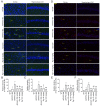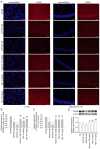Ginsenoside Rg1 alleviates learning and memory impairments and Aβ disposition through inhibiting NLRP1 inflammasome and autophagy dysfunction in APP/PS1 mice
- PMID: 36367174
- PMCID: PMC9685255
- DOI: 10.3892/mmr.2022.12893
Ginsenoside Rg1 alleviates learning and memory impairments and Aβ disposition through inhibiting NLRP1 inflammasome and autophagy dysfunction in APP/PS1 mice
Abstract
Alzheimer's disease (AD) is a common neurodegenerative disorder. Amyloid β (Aβ) deposition is considered an important pathological feature of AD. Growing evidence has linked neuroinflammation and autophagy to Aβ deposition in the progression of AD. However, there are few drug options for inhibiting neuroinflammation and autophagy to prevent AD. Ginsenoside Rg1 (Rg1), a steroidal saponin extracted from ginseng, has been reported to possess multiple neuroprotective effects. The present study aimed to evaluate whether Rg1 treatment could attenuate cognitive disorders and neuronal injuries by inhibiting NLRP1 inflammasome and autophagy dysfunction in an AD model of APP/PS1 mice. The results of behavioral tests indicated that Rg1 treatment for 12 weeks could significantly improve olfactory dysfunction as well as learning and memory impairments. The results of histopathological tests indicated that Rg1 treatment could reduce Aβ deposition and neuronal damages in APP/PS1‑9M mice. Additionally, the results of immunoblot, reverse transcription‑quantitative PCR or immunohistochemistry demonstrated that Rg1 treatment significantly downregulated the expression levels of inflammation‑related proteins of NLRP1, caspase1, IL‑1β and TNF‑α, as well as autophagy‑related proteins of p‑AMPK/AMPK, Beclin1 and LC3 II/LC3 I, and increased the expression levels of p‑mTOR/mTOR and P62 in APP/PS1‑9M mice. In addition, the molecular docking analysis showed that there was favorable binding result between Rg1 and NLRP1. The present study suggested that Rg1 may alleviate learning and memory impairments and Aβ disposition by inhibiting NLRP1 inflammasome and improving autophagy dysfunction, suggesting that Rg1 may be a potential therapeutic agent for delaying AD.
Keywords: AMPK/mTOR; APP/PS1 mice; Alzheimer's disease; Ginsenoside Rg1; NLRP1 inflammasome; autophagy.
Conflict of interest statement
The authors declare that they have no competing interests.
Figures








Similar articles
-
Inhibition of NLRP1 inflammasome improves autophagy dysfunction and Aβ disposition in APP/PS1 mice.Behav Brain Funct. 2023 Apr 13;19(1):7. doi: 10.1186/s12993-023-00209-8. Behav Brain Funct. 2023. PMID: 37055801 Free PMC article.
-
Rg1 improves Alzheimer's disease by regulating mitochondrial dynamics mediated by the AMPK/Drp1 signaling pathway.J Ethnopharmacol. 2025 Jan 31;340:119285. doi: 10.1016/j.jep.2024.119285. Epub 2024 Dec 27. J Ethnopharmacol. 2025. PMID: 39733799
-
S14G-humanin alleviates insulin resistance and increases autophagy in neurons of APP/PS1 transgenic mouse.J Cell Biochem. 2018 Apr;119(4):3111-3117. doi: 10.1002/jcb.26452. Epub 2017 Dec 26. J Cell Biochem. 2018. PMID: 29058763
-
Panax ginseng as an adjuvant treatment for Alzheimer's disease.J Ginseng Res. 2018 Oct;42(4):401-411. doi: 10.1016/j.jgr.2017.12.008. Epub 2018 Jan 12. J Ginseng Res. 2018. PMID: 30337800 Free PMC article. Review.
-
The Molecular Mechanisms of Neuroinflammation in Alzheimer's Disease, the Consequence of Neural Cell Death.Int J Mol Sci. 2023 Jul 21;24(14):11757. doi: 10.3390/ijms241411757. Int J Mol Sci. 2023. PMID: 37511515 Free PMC article. Review.
Cited by
-
Ginsenoside Rg1 in Parkinson's disease: from basic research to clinical applications.Front Pharmacol. 2025 Apr 16;16:1490480. doi: 10.3389/fphar.2025.1490480. eCollection 2025. Front Pharmacol. 2025. PMID: 40308780 Free PMC article. Review.
-
Research Progress on Natural Plant Molecules in Regulating the Blood-Brain Barrier in Alzheimer's Disease.Molecules. 2023 Nov 16;28(22):7631. doi: 10.3390/molecules28227631. Molecules. 2023. PMID: 38005352 Free PMC article. Review.
-
Exploring the Potential Therapeutic Approach Using Ginsenosides for the Management of Neurodegenerative Disorders.Mol Biotechnol. 2024 Jul;66(7):1520-1536. doi: 10.1007/s12033-023-00783-2. Epub 2023 Jun 18. Mol Biotechnol. 2024. PMID: 37330923 Review.
-
Advancements and challenges in pharmacokinetic and pharmacodynamic research on the traditional Chinese medicine saponins: a comprehensive review.Front Pharmacol. 2024 May 7;15:1393409. doi: 10.3389/fphar.2024.1393409. eCollection 2024. Front Pharmacol. 2024. PMID: 38774213 Free PMC article. Review.
-
Steroidal saponins: Natural compounds with the potential to reverse tumor drug resistance (Review).Oncol Lett. 2024 Oct 3;28(6):585. doi: 10.3892/ol.2024.14719. eCollection 2024 Dec. Oncol Lett. 2024. PMID: 39421314 Free PMC article. Review.
References
MeSH terms
Substances
LinkOut - more resources
Full Text Sources
Medical
Miscellaneous

